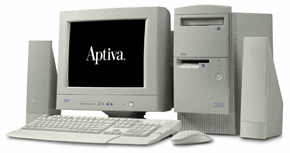IBM Aptiva Tech Support
FORUM
Membership isfree
Join Today
Most Popular
Performing a Clean Install of Windows 98
Adding a 2nd Hard Drive in an IBM Aptiva
Need some help? Visit the Forum
IBM Aptiva Tech Support
FORUM
Membership isfree
Performing a Clean Install of Windows 98
Adding a 2nd Hard Drive in an IBM Aptiva
Need some help? Visit the Forum
The IBM Aptiva personal computer was introduced in September 1994 as the replacement for the IBM PS/1. The first Aptiva models were based on the Intel 80486 CPU with later models using the Pentium and AMD CPUs. All systems were developed in-house except for the later E series which was developed by Acer. The last system was withdrawn in May 2001 without direct replacement when IBM decided to exit the home market. Customers were directed to the IBM NetVista, which was more targeted to business desktops. Most Aptiva models included a modem and a standby/hibernation feature called "Rapid Resume".
Aptiva computers were typically sold as a bundle which included monitor, speakers, keyboard and mouse. First generation models came with IBM PC DOS 6.3 and Windows 3.1. Pentium generation Aptivas came with Windows 95 and OS/2 'select-a-system' (PC DOS 7/Windows 3.1 and OS/2 Warp) on selected models.
Sound and modem functionality was provided on M, A, C and S models by an IBM Mwave adapter. The Mwave adaptor had multiple compatibility and performance issues and was eventually replaced by standard modems and sound cards. IBM settled a lawsuit for Mwave owners by refunding Aptiva Mwave owners a small monetary fee so that those owners could purchase industry standard devices.
Among other things, IBM's development and marketing of Lotus SmartSuite and OS/2 placed it in direct competition with Microsoft Office and Microsoft Windows, respectively. As a result, Microsoft "punished the IBM PC Company with higher prices, a late license for Windows 95, and the withholding of technical and marketing support."
IBM was not granted OEM rights for Windows 95 until 15 minutes prior to the release of Windows 95, August 24, 1995. Because of this uncertainty, IBM machines were sold without Windows 95, while Compaq, HP, and other companies sold machines with Windows 95 from day one.
The Aptiva never managed to recapture IBM's early 1980s PC dominance from Compaq, Dell, or HP. IBM's PC Group had higher costs than its competitors which made it impossible to match them on prices. Throughout the 1990s, IBM lost the most market share in PCs during that decade compared to its rivals, and only the ThinkPad laptop remained a stronghold. Most desktop and laptop sales were with longstanding corporate customers that already used IBM mainframe computers. Despite IBM's continued decline in hardware, that was more than offset by the company shifting focus to the more lucrative e-business (integrated e-commerce and Internet technology solutions). By 2005, IBM had sold the Personal Computing Division to Lenovo.
To understand which 'series' a Pentium-based Aptiva belongs to look at the first letter of the 3 character model number (so a 2168-M40 is an M Series). The word in quotes relates to the internal development name for the computer.
A Series Followed the M series Aptiva. Also used Mwave adaptor and Windows 95.Aptiva machine types
2134, 2136, 2137, 2138
The first generation of Aptivas used the 2144 desktop and 2168 tower unit form factors. The 2159 "stealth" series was a unique all black design that had the monitor resting on a metal stand with a 'console' located underneath which contained the floppy and CD drive. The console connected to the main unit via a 6-foot cable. Later in the production life, all Aptivas used tower unit form factors. Originally the 2144 and 2168 machine types referred to the amount of open slots and drive bays. Later machine type numbers did not have the same nomenclature.
I'm not DON5408, just keeping his site alive! But in addition to hosting a mirror site, I have added a few more things, mainly the new Aptiva Support Forum. I'm pretty sure there are some Fellow Aptiva Owners out there who need some help on their IBM Aptiva computer projects. So please join the Unofficial HelpCenter Community!
© 2025, aptivasupport.com. This site is not affiliated to IBM in any way.